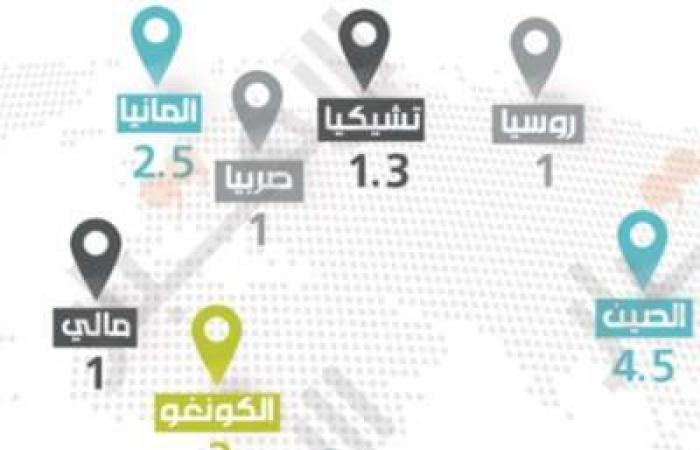What increases the risk of a shortage of supply is that the extraction of “lithium” is a complicated, expensive and time-consuming process. The brine is drawn under a salt crust that is formed due to natural factors, and placed in special pools exposed to the sun and air for evaporation. The resultant from this process undergoes a crystalizing process aimed at extracting the other salts in the remaining solution. After that, the product is purified and finished with a concentrated solution of “lithium”.
69.000
The price of a metric ton of lithium metal traded on international exchanges, which is 25% lower than its price in the past T1
The second way to extract it is no less difficult and complicated. It is present in the structure of solid rocks, which are crushed and “roasted” with the aim of turning it into powder. Later, the powder is subjected to a series of roasting, after adding substances to it, such as sulfur acid and black ash, until the refining and purification process is carried out to obtain a substance with a high concentration of “lithium”. Currently, laboratories in producing companies around the world are working on using new materials in the extraction process to provide a significant part of the production cost through lower temperatures sufficient to complete the roasting process (the used part of the rock).
This metal is used mainly to make batteries. This point of use accounts for 65% of the annual production, but it has other uses such as ceramics and glass, which account for 18% of the production, lubricating grease consumes about 5%, and the polymer industry 3%.
The largest non-extracted stock of lithium is in Bolivia. It is estimated that the available quantity for extraction is 21 million tons, followed by Argentina, which stores about 17 million tons, Chile with 9 million tons, and Australia with 6.3 million tons. In total, the US Geological Survey estimates that there are 80 million tons not yet extracted.
But in terms of extractive volumes, Australia comes first. Last year, its production reached 42,000 tons. While the quantity produced in Argentina was about 6,400 tons, and China was 7,500 tons.
On the consumption side, statistics indicate that China is the largest consumer of this mineral. Its market share is 39% of world production. This is due to China’s production policies in high value-added technological goods. It has made a strong entry into the field of manufacturing lithium batteries, and it has acquired a large portion of the global market. According to Benchmark Mineral Intelligence, a London-based research firm, out of 136 companies that manufacture lithium batteries, 101 are based in China. China’s destination is more evident through its investment in lithium extraction and manufacturing. The Chinese company, Tianqiu Lithium, recently bought $ 4 billion in shares of SQL, which is one of the largest producers of lithium in Chile. Thus, the Chinese company became the second largest shareholder in the Chilean company, noting that this Chinese company owns 51% of the largest lithium field in Australia. Likewise, the Chinese company has a relative control over the production and manufacturing stages, that is, it has a hand that extends to the entire supply chain for the lithium batteries industry and its sales market as well.
Chinese acquisitions of production and manufacturing chains are a concern in the United States. The future of energy and associated technological production around the world depends on battery technology. If China continues this control, US companies producing goods that require rechargeable batteries will be relatively under the control of Chinese companies. The level of risk increases with the doubling of the level of dependence on this type of battery. As an indication, the coup in Bolivia was directly linked to the conflict over the white oil mines in Bolivia. The latter has the largest stockpile in the world. The owner of the company “Tesla” that manufactures electric cars (the issue of lithium metal and its prices is one of the biggest concerns of the company) Elon Musk expressed wide interest in the issue of the coup in Bolivia, and he tweeted last July, saying: “America can make a coup wherever it wants, and you have to.” Accept the subject ».



Subscribe to «News» on YouTube Here
These were the details of the news Struggle for $ 5.5 trillion for this day. We hope that we have succeeded by giving you the full details and information. To follow all our news, you can subscribe to the alerts system or to one of our different systems to provide you with all that is new.
It is also worth noting that the original news has been published and is available at saudi24news and the editorial team at AlKhaleej Today has confirmed it and it has been modified, and it may have been completely transferred or quoted from it and you can read and follow this news from its main source.

